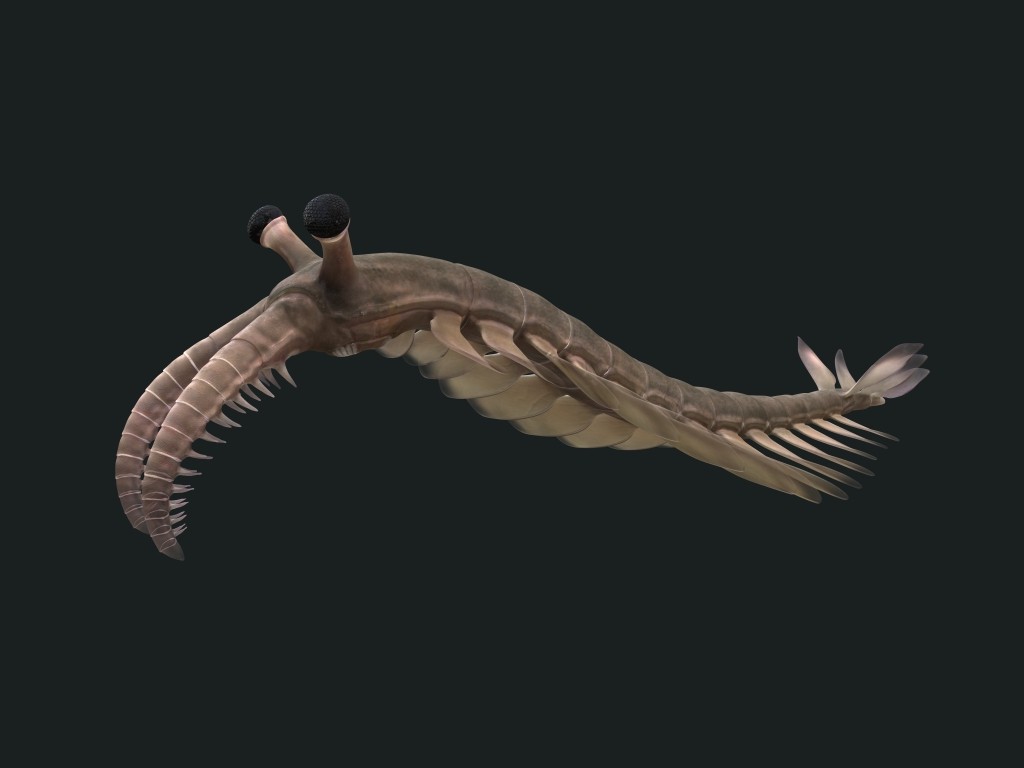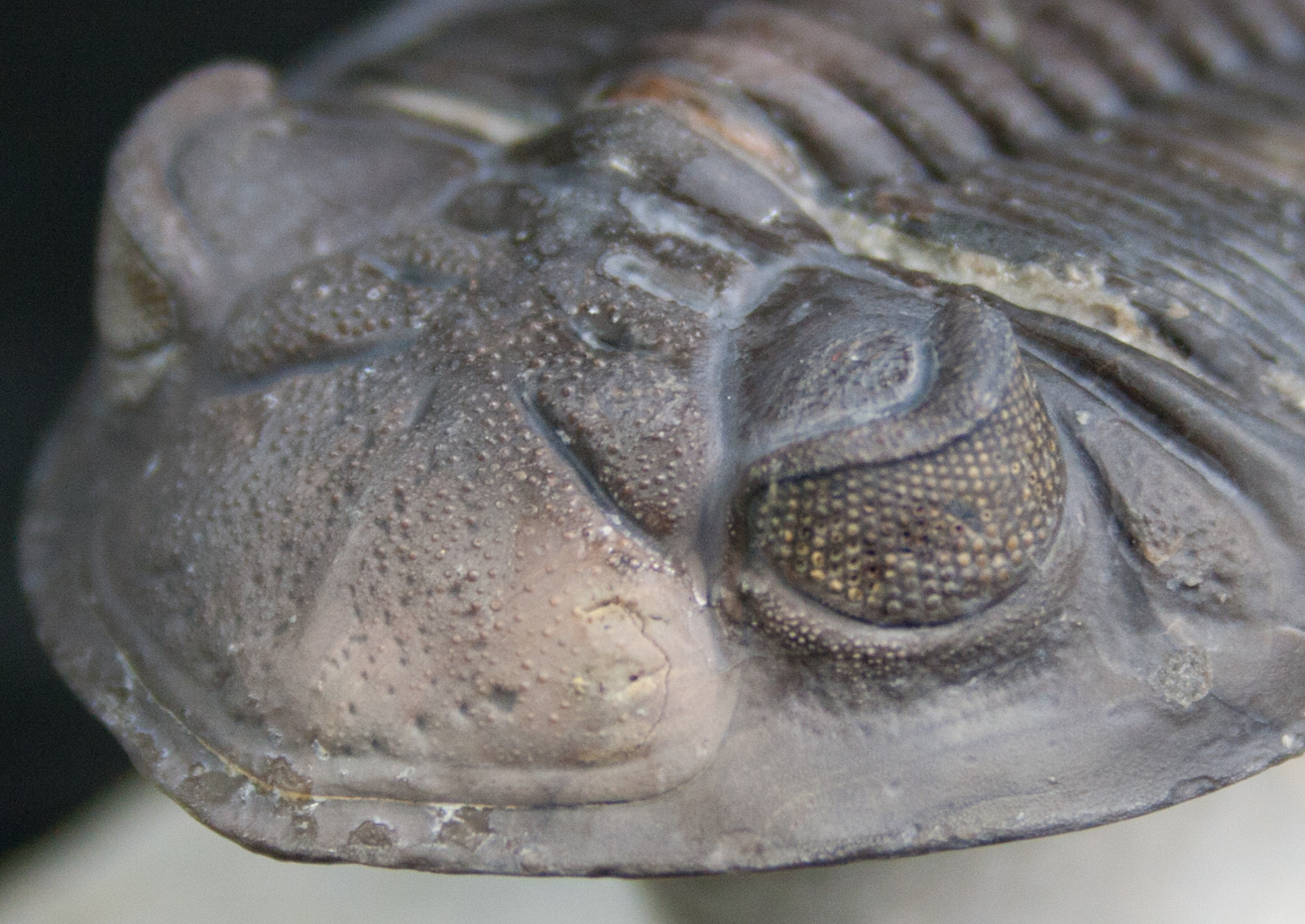"Fossil shrimp" anomalokaris and his complex faceted eyes

Anomalokaris or anomalokar is an unusual arthropod that lived in the ancient seas about 500 million years ago. Swam these "shrimp" using flexible side blades. The body size of the animal reached about one meter. The fossil remains of Anomalokaris were found as early as the 19th century, but for a long time, paleontologists could not understand what a living organism looked like. Paleontologists increasingly entangled the finds of partially preserved remains of anomalokaris. In 1892, for example, experts discovered the mouth appendages of this animal, deciding that they actually belonged to some of the primitive representatives of the crustaceans. A bit later parts of the mouth were discovered.
And only after almost a century it became clear that all of this is part of the same animal. Understanding how this “shrimp” actually looked like was possible after scientists in China, Australia and several other countries discovered full fossils, moreover, that were perfectly preserved. As it turned out, despite the antiquity, Anomalokaris had excellent vision.
And all thanks to the complex eyes. Once again it is worth recalling that this animal lived in the ancient seas more than 500 million years ago, long before the appearance of dinosaurs, insects and other land animals. And already then this animal had excellent eyesight, which helped him to examine everything around. Why all this?
')
Paleontologists believe that Anomalocaris was a “king” in the ancient world, a predator from whom there was no escape. Presumably, the victims could not escape from the grasping limbs of the animal littered with small chitin needles. After a brief struggle, Anomalocaris sent the victim into his square mouth. The fossil “shrimp” floated rather quickly, not only due to the side blades, but also due to its tail. Well, in order to see the victim from afar, the arthropod inhabitant of the ancient warm waters needed good vision.

Fragment of the prehensile limb of the animal
The fact that Anomalocaris had complex eyes, paleontologists learned relatively recently. This discovery was one of the first to be made by John Paterson of the University of New England. He found fossils with well-preserved mineralized eyes. If the scientist is right, then the vision of anomalokaris was superior to that of most modern owners of faceted eyes, insects. The complex eyes of the anomalokaris were located at the ends of the relatively small lateral protrusions of the “head”, which provided the animal with an almost complete circular view.
Facet eyes (fr. Facette— "face") - the main paired organ of vision of insects, crustaceans, and some other arthropods. Basically, faceted eyes provide color vision with the perception of ultraviolet rays and the direction of polarization of linearly polarized light, with poor discernment of fine details, but good ability to distinguish flickering (blinking) of light with a frequency of up to 250—300 Hz (for humans, the limiting frequency is about 50 Hz).
The faceted eyes consist of separate structural units called ommatidia. They look like narrow, strongly elongated cones, converging with their tops deep in their eyes, and forming a mesh surface with their bases.
Each ommatidia has a very limited viewing angle. A separate element “sees” only that tiny area of an object in front of his eyes, to which the continuation of the axis of this ommatidia is directed; but since ommatidia closely adjoin each other, and their axes diverge in a ray-like manner, the compound eye covers the object as a whole, and the image of the object turns out to be mosaic (that is, composed of many separate pieces) and straight (and not inverted, as in the eye). person).
 Paterson was lucky - he discovered the mineralized eyes of a certain ancient creature in the rock formation of the Emu Bay Shale of South Australia. “In these sediments, the remains of animals that do not have a skeleton or something similar have been well preserved, thanks to which even soft tissues, including muscles, are preserved,” said Paterson. But even in this case, he was very lucky, because the discovery of the eyes of ancient animals in the fossils is a rare phenomenon. For many years, the scientist discovered 5000 fossilized fossils. And only one of them turned out to be mineralized eyes.
Paterson was lucky - he discovered the mineralized eyes of a certain ancient creature in the rock formation of the Emu Bay Shale of South Australia. “In these sediments, the remains of animals that do not have a skeleton or something similar have been well preserved, thanks to which even soft tissues, including muscles, are preserved,” said Paterson. But even in this case, he was very lucky, because the discovery of the eyes of ancient animals in the fossils is a rare phenomenon. For many years, the scientist discovered 5000 fossilized fossils. And only one of them turned out to be mineralized eyes.The most interesting thing is that the eyes are preserved, but for some reason the body does not. The size of the detected eyes was 2 centimeters, they were convex. At the time of the discovery of the belonging of the eyes had to guess. According to scientists, at that time the only sufficiently large animals that could have such eyes was anomalokaris. Each of the eyes found consisted of 16,700 facets, miniature lenses, which together provide its owner with excellent vision. Moreover, these are only facets that have been calculated on the well-preserved side of the eye. How many were there really - a question. Only in a few modern insects the number of facets in the eyes (up to 28,000 in some species of dragonflies) approaches their number in the ancient eyes of the arthropod detected by the paleontologist.

Now scientists are trying to understand when the ancestors of Anomalokaris got complex faceted eyes. According to some experts, this should have happened long before the appearance of the rigid exoskeleton of the animal.
Because of the antiquity of the remains, the study of anomalokaris is a difficult task. Until now, scientists argue what kind of life these ancient predators led (there is practically no doubt about it). The fact is that on the shells of some trilobites were found marks, which, according to scientists, could leave anomalous caris. On the other hand, the oral apparatus and other parts of the body of this animal were not so hard to be able to damage the strong trilobite shell.

By the way, trilobites also had complex eyes , the structure of which is unique. Their structure was radically different from the structure of the eyes of modern animals. These animals did not have a crystalline crystalline lens; instead, trilobites had calcite mineral lenses. Currently, the only animals with mineral visual lenses are some of the currently existing brittle cameras and the Acanthopleura granulata mollusk. The complexity of the trilobite eyes was much higher than those of our contemporaries.
Here, too, the question arises of the appearance of trilobite eyes - it is not yet clear when exactly they appeared, and how the evolution process took place. All this is extremely important for clarifying the history of the origin of life on Earth and the then evolutionary processes.
Source: https://habr.com/ru/post/399591/
All Articles